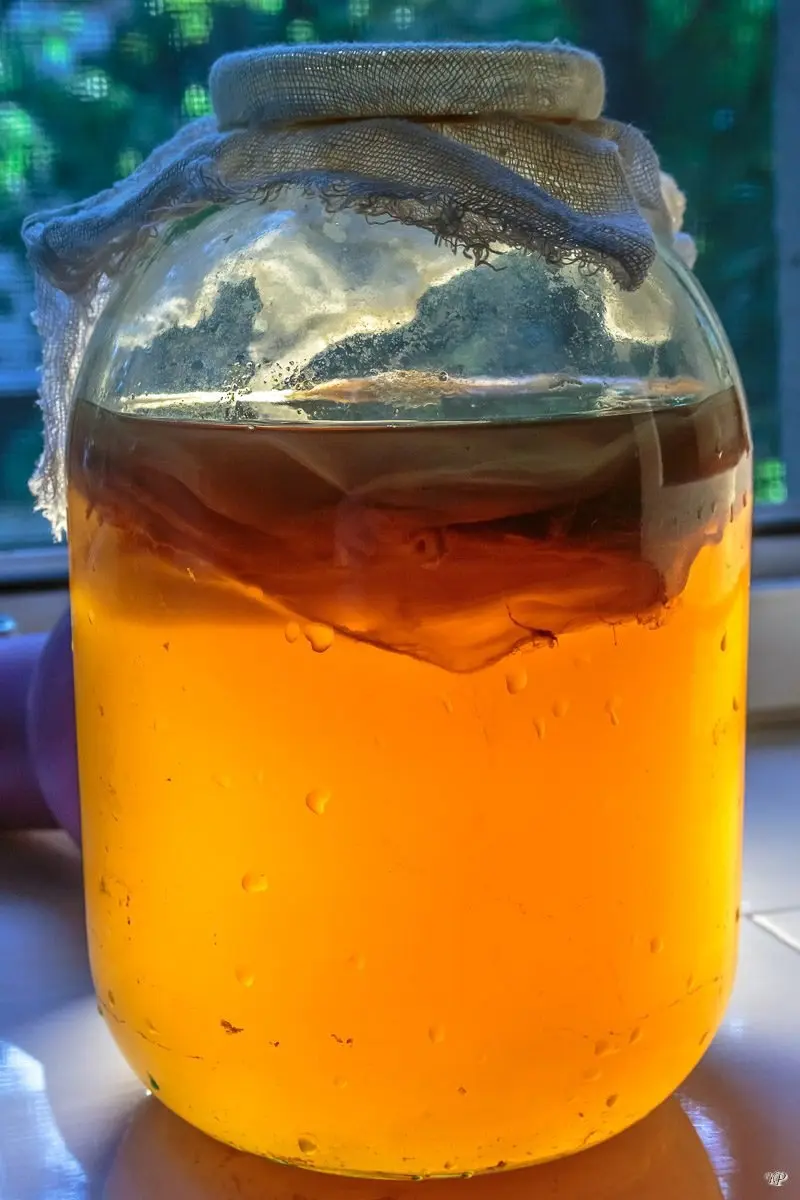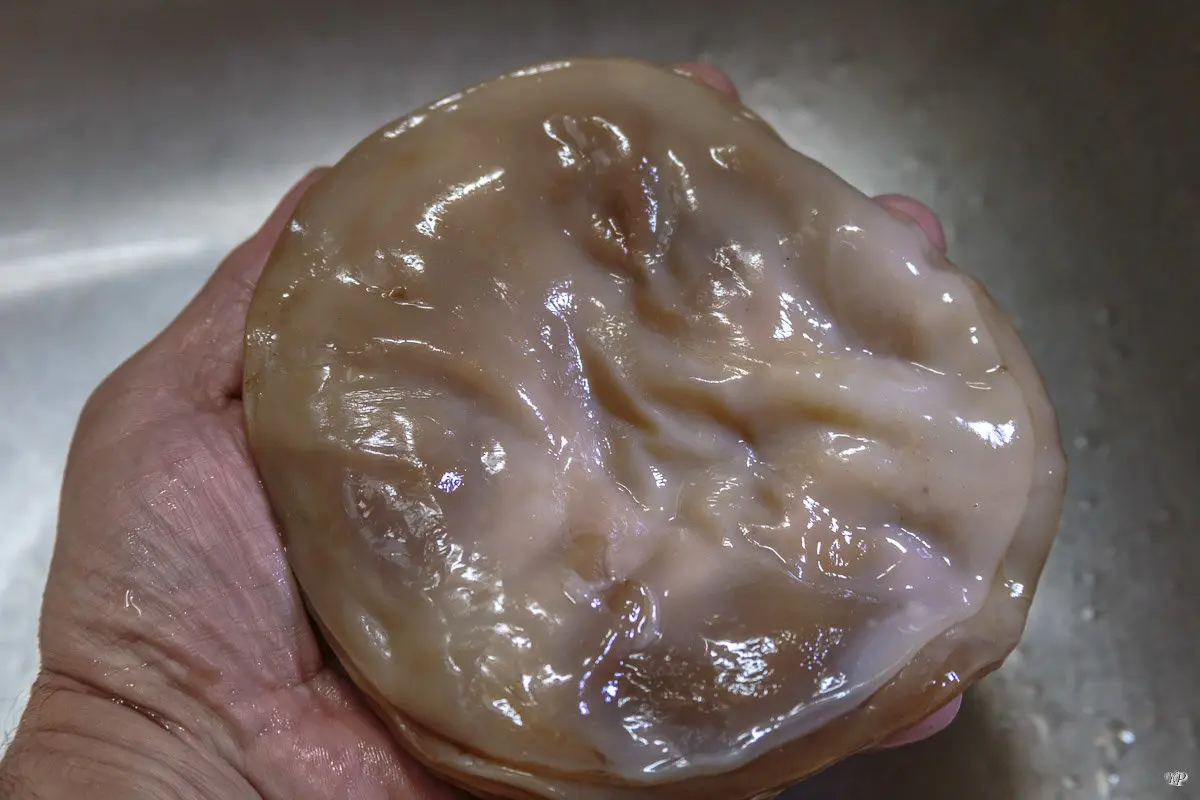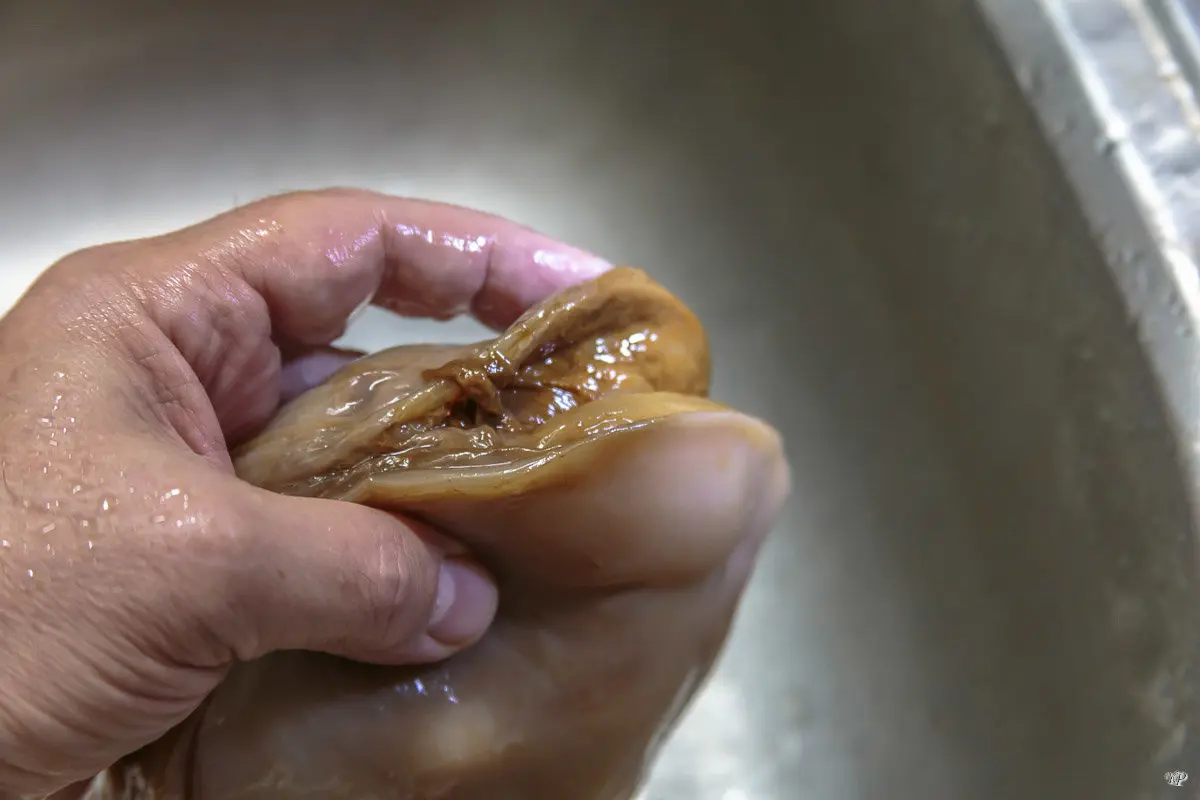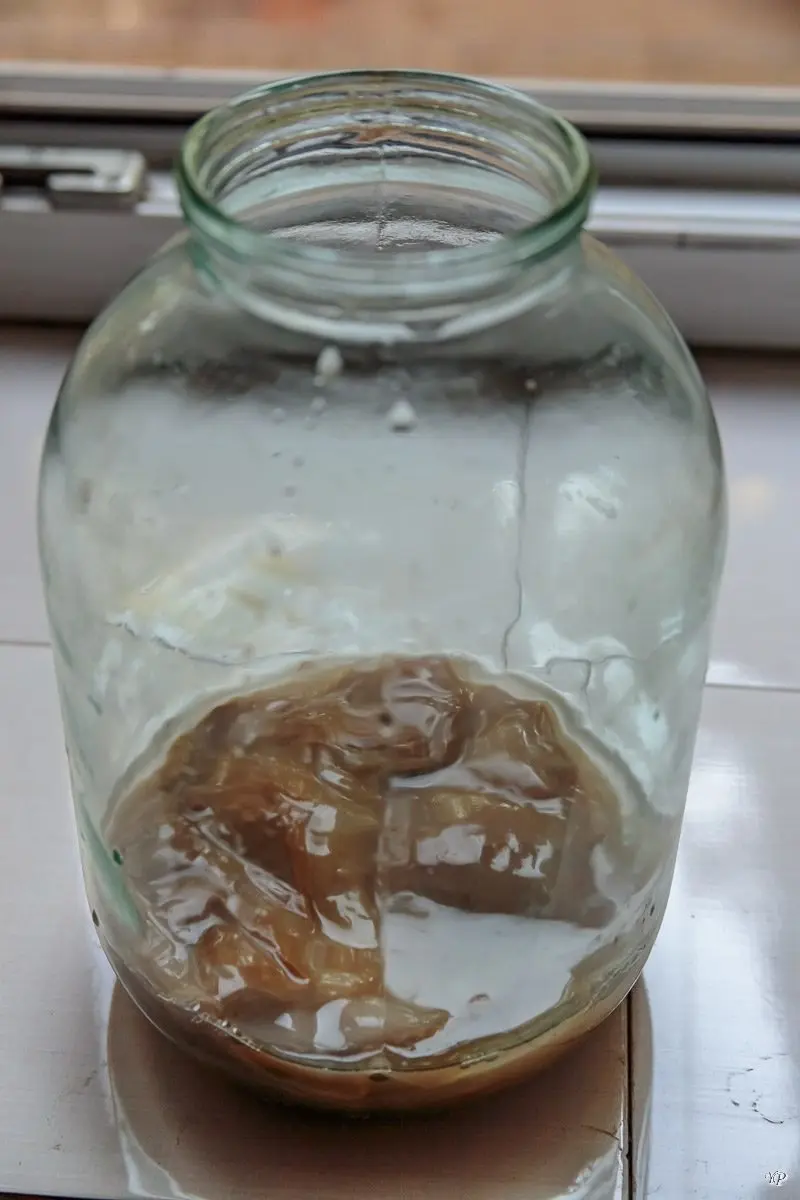Tea mushroom
- Kombucha

Tea mushroom. An incomprehensible slippery something floating in a jar neatly covered with clean gauze. Weekly care procedure: drain the finished drink, rinse the mushroom, prepare a new sweet solution for it and send it back to the jar. We observe how this jellyfish straightens out, takes a comfortable position for itself. Here it is, the true “tea ceremony”, no need to go to China, everything is at our fingertips.
I remember how this strange jellyfish appeared in our family.
Mom then worked at the University and often told all sorts of news, either from the world of “high science”, or from the world of near-scientific speculation. I was still quite small, a preschooler, and greedily caught all sorts of tricky words in order to scare my friends later. For example, the word “acupuncture” is a scary word, right? Especially when you are 6 years old and you are terribly afraid of injections. But you sit and listen, as if spellbound, because this is sheer magic: to poke just needles, empty needles, without syringes with nasty vaccinations, from which the skin then itches, into the “right” points, and all diseases go away! All! But, really, in order to know these “correct points”, you need to study for a long time, many years. This revelation somewhat cooled my childish ardor to immediately arm myself with a pack of needles and go treat everyone in a row, from a dozen chickens in the hen house and our aging cat to the neighbor’s vicious little dog.
And then one evening, my mother returned from work, carefully carrying some strange saucepan in a string bag. Solemnly she placed the saucepan on the table. My grandmother and I were impatiently waiting to see what was there. I, of course, hoped that there was some new delicacy. Mom opened the lid, I looked inside … Medusa! A nasty, dying, yellowish-hazy-brownish jellyfish lay at the bottom of the saucepan, slightly covered with a transparent yellowish liquid.
Silent scene. Brutal, you know, like in the best productions of The Government Inspector.
Grandmother was the first to find the power of speech: “What the hell is that?”
Mom, apparently, was ready for such a reception. She slowly washed her hands, took a plate, deftly picked up a jellyfish from a saucepan, put it in a plate and began to tell.

To be honest, I don’t remember much of that story. I remember pictures and impressions. If there were abstruse words like “Acupuncture”, perhaps I would remember more. I remember how strange it was for me to watch my mother take this monster with her hands, explaining where it has top and bottom, and that it grows in “layers”.

Mom, without stopping telling, prepared a home for the jellyfish: she poured boiled water into a three-liter jar (this is the end of the sixties, the concept of “purchased drinking water” was absent as such, we always boiled tap water), added some sugar and topped up the tea leaves from the teapot. Shake the jar to make the sugar dissolve faster. She took the jellyfish in her hands again and released it into the jar. But now I knew it wasn’t a jellyfish, it was a kombucha. The mushroom thumped into the jar almost to the very bottom, then slowly began to straighten and rise. We sat and, spellbound, watched how it occupied the entire space of the jar in width, how the jar turned out to fit him exactly (long live GOST and standardized glass container sizes!), how he slowly rises.
Mom took the cups and poured liquid from the saucepan into them. “Try!” Grandmother pursed her lips in disgust and flatly refused. I, looking at my grandmother, of course, also refused. Later, in the evening, the men, father and grandfather, drank the drink, I didn’t understand the reaction, it seems they didn’t like it.
It was the beginning of summer and it was hot.
Grandma always made kvass. Simple homemade kvass according to a simple recipe, without any starter cultures: dried real “black” round bread, unwashed black raisins, sugar and water. Kvass was aged in traditional three-liter jars. A jar of kombucha took its place in the same row. In the heat, I was constantly thirsty, and grandmother’s kvass was the most affordable. Who remembers those times? There were soda machines, 1 kopeck – just soda, 3 kopecks – soda with syrup. The machines were not crowded, we then lived on the outskirts, there were only two of them within walking distance, but I was not allowed to go to one of them, since I had to cross the road there. And something always ended there: there was no water, then syrup. You come like a fool with your glass, but there is no water. It was possible, if you were lucky, to buy soda or lemonade in a half-liter bottle, but they didn’t give me money for this (it seemed to cost a little more than 20 kopecks, I only got such a lot of money at school, when I could save on breakfast). Therefore, grandmother’s kvass saved from thirst: you run into the kitchen, grab a cup, quickly grab a jar, pour a magic drink right through the cheesecloth and drink it. This absolutely unforgettable taste! That’s how much I tried different types of kvass later, in the post-Soviet period, I never found anything like it.
Three weeks have passed since the evening when my mother brought someone else’s saucepan into the house. The story about the jellyfish that settled with us has already disappeared from my memory, I don’t remember at all who looked after Kombucha and where the drink went.
And then one day exactly what was supposed to happen happened, which you, my dear reader, have, of course, already guessed. Yes. I flew into the kitchen, grabbed a jar without looking, poured myself kvass and began to drink greedily. I took a few full sips before I realized: I don’t drink kvass. Oh, not kvass… Despite the general similarity – sweet and sour and slightly carbonated – the taste was completely different. I lift the gauze – in the jar, from which I just poured myself kvass, a jellyfish sways. Fairly enlarged since the moment we first met.
It’s funny that I didn’t have any negative emotions. I was very thirsty, and the drink was really tasty. She drank slowly, in small sips, trying to get a better taste. Quite good taste! The fact that kombucha contains a small percentage of alcohol, I learned about eight years later, like the word “Kombucha”. Then we called it simply: “mushroom”. The question “What will you drink, kvass or mushroom?” understood clearly.
What can I say … a week later I was already a super-expert on the “mushroom”, hooked all my friends on it, a line of neighbors lined up for the “sprouts” to my grandmother.
When I went to school, the parents of my classmates lined up. I could easily and without hesitation rattle off “point by point” what Kombucha is:
- it’s alive
- it’s not a jellyfish
- this is a mushroom
- he is growing
- he lives in a bank
- he makes a drink like kvass, but tastier
- I am allowed to drink this drink
- This drink does not damage your teeth.
This uncomplicated children’s marketing had an effect on everyone, and little by little jars of mushrooms spread throughout all the kitchens of the microdistrict.
Years have passed. Our outskirts went under demolition, we got an apartment in a new building, in another area. We moved for a long time, hard, it was summer and again it was hot.

The mushroom was transported in a jar, from which almost all the liquid was drained. And they forgot about him. Ten days, maybe more. We found the jar by the smell, the sour specific smell of stagnant yeast fermentation with rot. The mushroom was wrinkled, the top was completely dry, the bottom layer was still wet, but somehow very unhealthy. I don’t even know why we tried to revive him? It was possible to take a process without problems. But it was interesting. The mushroom was washed several times with lukewarm water and dipped in a freshly prepared solution of sweet tea. He drowned. All. Went to the bottom like a submarine. For a couple of hours I still came up to see how my pet was doing, then I spat.
And in the morning I found that he came to life! Came up to half the height of the jar and looked much better. By the end of the day, he surfaced just like he should. The top layer was dark, there was something painful in it. I changed the solution for him a couple of times and poured out this liquid, I was afraid to drink, I tore off the top layer and threw it away. The mushroom agreed to live in a new apartment and forgave us our forgetfulness. Amazing vitality!
In the fall, I started ninth grade at a new school. And during the autumn holidays, classmates came to visit me. We saw a jar: what is it? I took in more air into my chest to drum out the usual “this is alive …” – and stopped. The text that you proudly recite as an elementary school student will somehow be perceived wildly when you are already a young lady from high school, a Komsomol member, an activist.
In a nutshell, she said that it was kombucha and that this liquid can be drunk. And the next day I went to the library.
Yes, yes, do not laugh: to the reading room. This is the end of the seventies, the word “Internet” did not exist then, as well as the Internet itself.
She studied the filings of the magazines “Health”, “Worker”, “Peasant Woman” and something else, it seems, “Soviet Woman”.
A couple of articles about kombucha were found in each file. I then made disappointing conclusions for myself: no one really knows what it is and how it affects the body. But it doesn’t seem to hurt. And thanks for that. Where it came from in the USSR is also unknown. And why exactly tea? Kombucha, it turns out, can live in milk and juices.
My “marketing” theses at that time looked something like this:
- it is a living organism
- he has long been known in the East
- kombucha drink is generally good for health
- it boosts immunity
- it improves metabolism
- it cures a lot of diseases
- it helps to lose weight
- it has alcohol in it!
The last item on this list, as you understand, was strictly for classmates, not for their parents.
For a year, my entire parallel was already with a mushroom. Such is the “cyclical nature of history”.
But the mushroom did a full cycle when I entered the university. I entered the same university, KhSU, where my mother once worked. First, I gave a few shoots to the girls in the hostel. Then she began to offer classmates: do not throw them away, these “pancakes”? And then, it was already in my second year, the teacher called me and asked what I brought in a jar and gave it to my classmate? Isn’t this the “Indian mushroom”, a drink from which treats gastritis? I admitted that I hear about gastritis for the first time, but if it is gastritis with high acidity, then drinking this drink is unlikely to work: there will be constant heartburn. And that the name “Indian mushroom” is also, in general, I hear for the first time, we simply call it Kombucha.
“Yes Yes! the teacher was delighted. “That’s right, teapot!” Can you sell me the sprout?”
I replied that I don’t sell them, but distribute them “completely without-air-mez-bottom, that is, for free” (activist, Komsomol member, early eighties, what a sale, what are you!)
We agreed to barter: the teacher brought me a few grains of “Sea Rice”, I made her happy with a kombucha pancake. A couple of weeks later, I accidentally found out that the department had already lined up for processes.
My mother brought kombucha from the university, from the Department of Low Temperature Physics. I brought it to the same university, to the department of the history of foreign literature. The mushroom has come full circle.
Then … then I got married, gave birth, the mushroom disappeared from my life.
And a few days ago, while tidying up the Kombucha section, I thought: what’s new on this topic? As of now, end of August 2019? Tell me Google…
Here’s what we managed to scrape together:
- there is still no reliable information about where the fashion came from to ferment a sugar solution using the so-called “Kombucha”
- there is no exact information where he comes from, is it Egypt, India or China
- it is absolutely unknown who and when brought it to the USSR
- on the other hand, it is known that in the USA it gained incredible popularity in the 90s of the last century and continues to spread aggressively, but not for free, through acquaintances, from hand to hand, as it was with us, but for money
- The kombucha drink market in the US is valued at some absolutely insane millions of dollars ($556 million in 2017) and continues to grow, sales of kombucha in the world in 2016 amounted to just over 1 billion dollars, and by 2022 may grow to 2,5 billion
- the word “Kombucha” came into common use instead of the long and unpronounceable “drink produced by kombucha”
- there is no reliable information about how useful Kombucha is when used regularly
- periodically there are viral news about alleged deaths among Kombucha worshipers, but there is no reliable evidence either
- there are a huge number of recipes with kombucha, almost all of these recipes contain herbal preparations, they must be treated with due care
- Kombucha consumers have become much younger, they are no longer grandmothers who have a jar of kombucha on a par with kvass. The Pepsi generation chooses Kombucha!









